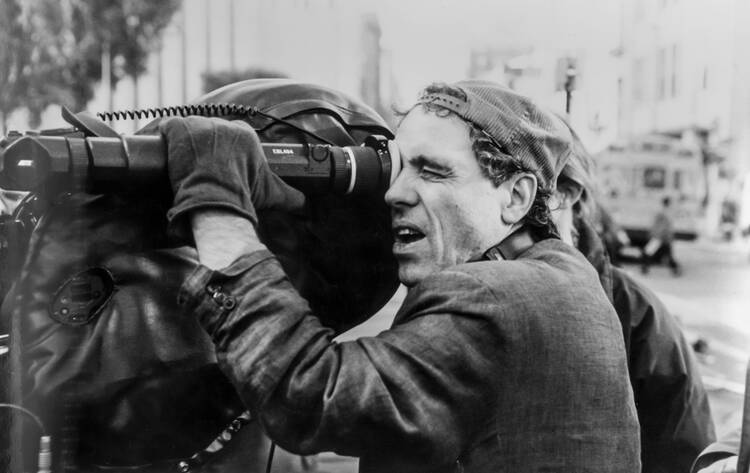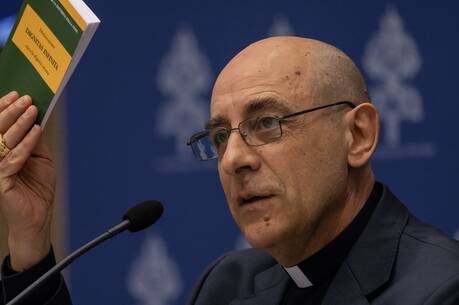You would be hard pressed to find a new Abel Ferrara film at a movie theater not attached to a film festival. You would be in a similar dilemma if you tried to find the films that bookend the director’s commercial (though not his artistic) peak on any sort of streaming service. The uniformly excellent “Bad Lieutenant” (1992) and “King of New York” (1990) are two of the director’s easy-to-track-down films. As for equally great films, such as “The Blackout” (1997) or his pilot for the Michael Mann-produced TV series “Crime Story” (1986), Ferrara has taken to telling fans to search for them on the “dark web.”
Beyond the frustration of not being able to engage with such a rich and consistently challenging filmography, it is simply maddening that films featuring such revered screen types as Christopher Walken, Isabella Rossellini, Harvey Keitel, Willem Dafoe and even Madonna are sequestered in legal limbo. It is a mark of Ferrara’s status as a master of his medium that so many are willing to forgo more lucrative opportunities to work with the director.
You would be hard pressed to find a new Abel Ferrara film at a movie theater not attached to a film festival.
The Ferrara drought was alleviated momentarily last May by the Museum of Modern Art in New York, which presented a complete retrospective, “Abel Ferrara: Unrated.” For this to be a truly comprehensive series, prints of the films were outsourced from France (where Ferrara remains more respected than in his native United States) and from the director’s personal collection. Given a prime chance to burrow even further into Ferrara’s work, one could affirm his singularity. It can be hard to stomach the viscerality of Ferrara’s cinematic language, especially when you consider how much of himself is traceable across his company of addicts, gangsters and recovering alcoholics.
Of course, Ferrara has never been a stranger to self-reflective filmmaking. His earlier work situates itself within the New York milieu his Italian-Irish and Catholic upbringing in the Bronx—and a brief stint in pornography (to pay the bills that go with being a young filmmaker)—would have exposed him to. This biography can cause film buffs to reflexively compare Ferrara to Martin Scorsese (also Italian, and in his case, still Catholic, while Ferrara converted to Buddhism in the mid 2000s), and slap the subsequent films with the tags of exploitation or pulp. Sidestepping hyperbole, Dennis Lim concisely summed up Ferrara as the “unofficial poet laureate of pre-Giuliani New York.” Though Ferrara’s films take on many forms, all come with the innate desire to simply portray New York City, all forms of commentary coming second.
Ferrara’s work situates itself within the New York milieu his Italian-Irish and Catholic upbringing in the Bronx.
Ferrara’s directorial vision isn’t inextricably tied to New York, however. As the director has decamped to different locales—from California to Rome—his films have followed, demonstrating how thematic concerns can be informed by all sorts of locations, and vice versa. But the most consistent and traceable through-line in Ferrara’s work isn’t necessarily one of subject matter—he has long since moved past the B-movie, N.Y.C.-indebted machinations of his earlier work—but of characters, namely those experiencing faith on a visceral, sometimes unquantifiable level.
Choosing to depict moments of faith in both crisis and transcendence is working on well-trodden ground; presenting faith as a more enigmatic and very much visceral entity is what sets Ferrara apart, and possibly what has distinguished him as a cult figure. Other filmmakers who are known to grapple with questions of faith still provide easy entry points. For Scorsese, it’s Catholic guilt; for Ingmar Bergman, the silence of God; for Terrence Malick, it’s faith as a redemptive force.
Ferrara is not interested in concise portrayals, but those that are rendered with a kind of stomach-churning uncertainty.
Ferrara is not interested in concise portrayals, but those that are rendered with a kind of stomach-churning uncertainty, allowing for moments of proof of the divine as well as the exact opposite. In a typical move, he transplants the story of Jesus to a New York gangster in “King of New York,” freshly released from prison, whose attempts to do good are hounded by local police and undermined by betrayals. Ultimately, he sacrifices himself, dying in the back of a yellow cab with a bullet in his belly, the driver’s rear-view mirror rosary in view.
Or take one of the purest distillations of the Ferrara ethos, “Bad Lieutenant.” Harvey Keitel, in a performance of pure nerves, grunts, tears and drug use, is the unnamed lieutenant., the very definition of a crooked cop, more than happy to steal evidence bags of coke, take bets on the ’91 Mets and harass teenage girls, flaunting his badge and authority as a means of doing so. He is also a Catholic and attends Mass; when his go-between for baseball betting outlines the increasingly dangerous situation the lieutenant is embroiled in, he replies simply with, “No one can kill me, I’m blessed. I’m a f— Catholic.” He then places another bet on the Dodgers beating the Mets, which proves to be a death sentence.
There is the faint promise of some sort of course correction when the lieutenant begins investigating the brutal rape of a nun in Spanish Harlem, which is paralleled with a further descent into debauchery, suggesting a spiritual faith thrown into turmoil. The lieutenant comes to represent an approach to Catholic teaching that Ferrara described as: “It’s not that you’re pushed to read the Bible. The Bible is read to you.” Religion, in Ferrara’s view, should not be oversimplified and couched in exclusively negative or positive terms.
Religion, in Ferrara’s view, should not be oversimplified and couched in exclusively negative or positive terms.
We can assume the lieutenant is a Catholic in this simplified mode, identifying initially halfheartedly—from the opening scene in which he is yelling at his twin boys, and then bumping coke, he is shown as anything but benevolent—but then accepting his religion on its own, visceral ground. When the nun is raped, this event contradicts his ideas of a divine protection (the “no one can kill me” comment), and his ideas of religion are now placed in a sort of battleground, ideas of forgiveness and sacrifice crashing into one another and forming new, unfamiliar shapes.
The lieutenant only truly engages with Catholicism in a similarly spontaneous way, collapsing in the aisle of the crime scene’s church, screaming at an apparition of Jesus for answers on how to continue, on what to do. What in fact he wishes to continue, we are not exactly sure. Is he asking how to proceed with the case? Is he asking for more general guidance as his life continues on its downward spiral? What we can be sure of is that it is a sudden and explicit acknowledgement of faith, much more believable than the past assertion of being Catholic and therefore bulletproof.
“Bad Lieutenant” is Ferrara’s most straightforward depiction of a malleable faith, one that hits on a gut level. From there, the director would forgo explicit references to faith in favor of subtle implications of Catholic themes. Many characters are still Catholic—such as the Italian-American family at the center of “The Funeral” (1996)—but they are not exactly collapsing in pews, shrieking at Jesus.
“Bad Lieutenant” is Ferrara’s most straightforward depiction of a malleable faith, one that hits on a gut level.
“The Funeral” creates an air of discomfiting forgiveness and vengeance that speaks to the family’s religion, as well as the life-or-death circumstances of a criminal family that are created in such a milieu. As the Tempios cope with the killing of their youngest brother, Giovanni (Vincent Gallo), the reactions of the family members create an atmosphere of visceral tension, where, as in “Bad Lieutenant,” different Catholic ideals seem to bash into one another rather than coexist. Raimundo (Christopher Walken) is in a state of sober resignation and subsequent acceptance, and even borderline-reconciliation with the killer. Cesarino (a firebrand Chris Penn), however, is caught in a feedback loop of religious guilt and a desire for vengeance that pushes him to shoot his own brother and then take his own life at the end of the film. Toeing the line between faith and familial debt proves to be too much.
Ferrara would continue to subtly nod to Catholic iconography and teachings in subsequent films, and even after his conversion to Buddhism in 2007, still acknowledged spirituality as an unknowable force. Even when the background of characters becomes less discernible, they still engage in moments of reconciliation, acceptance and forgiveness. As formal acknowledgements of faith became less of a concern, the Ferrara protagonist—undeniably a surrogate for the director himself, in his struggles with addiction and self-preservation—became one consistently trying to reckon with the past while doing right by the future. Whether it be the recovering screenwriter trying to understand his murder of a young girl in “The Blackout,” or a corporate saboteur awash in the questionable memory of the buildup to a botched job in “New Rose Hotel” (1998), these characters still place themselves at the mercy of a higher, inscrutable force in order to better understand their own lives.
In his chamber piece, “4:44 Last Day On Earth” (2011), Ferrara provides a snapshot of a New York City couple spending their last hours in their Lower East Side apartment, waiting for the end of the world to occur at the titular time. Engaging in numerous coping mechanisms, from meditation to sex, the two come to embody an acceptance of the malleability of faith, pledging themselves not just to religion, but to each other, to art, to friends and family. This is heralded by the visceral nature of the situation––the promise of a literal rapture brings out repressed behaviors in many. But by pairing these moments with moments of surprisingly idyllic calm, Ferrara positions himself not just as one to grasp the sheer overwhelming concept of faith, but also as someone who can explore how it expands from there.
Ferrara’s first feature film, “The Driller Killer,” begins with a man played by Ferrara himself bolting from a church where he has come across his estranged father. Ferrara’s entire career has carried itself in a similar way ever since: capturing the moments where, for either better or worse, our concepts of faith collide and are disrupted.









